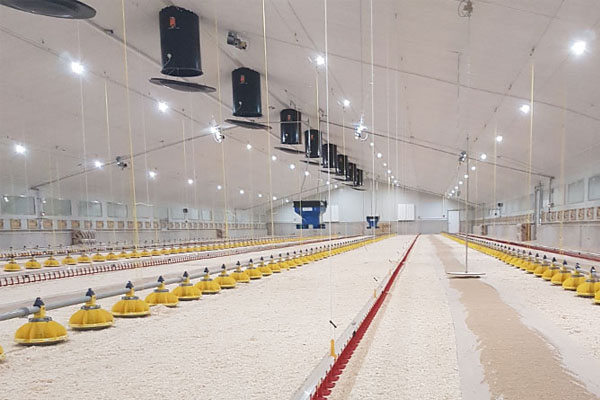Poultry House structure:
Protection from contaminants: Poultry houses in metal factory environments should be designed to prevent the ingress of dust, fumes, chemicals, or other potential contaminants. This may involve the use of air filtration systems, sealed walls, or advanced ventilation systems.
Durability: The structure of the poultry house should be able to withstand the nearby metal factory’s operations and potential exposure to heat, vibrations, or other environmental factors. Sturdy materials such as steel or reinforced concrete may be used.
Key features and considerations in designing a poultry housing structure:
1. Size and Layout: The size of the poultry house depends on the number of birds to be housed. It should provide enough space for the birds to move around comfortably. The layout should allow easy access for feeding, watering, and cleaning.

- Construction Materials: Poultry houses are typically made of durable materials such as wood, metal, or concrete. The choice of material depends on factors such as climate, availability, and cost-effectiveness.
Ventilation: Proper ventilation is essential to maintain a healthy environment inside the poultry house. It helps regulate temperature, remove excess moisture, and reduce the buildup of harmful gases like ammonia. Ventilation systems may include windows, exhaust fans, and air inlets.
- Lighting: Sufficient lighting is crucial for the growth and productivity of poultry. Natural light is preferred, but artificial lighting can be used to supplement it. A consistent lighting schedule is essential to maintain regular feeding patterns and optimize egg production.
- Insulation: Insulation helps to regulate temperature extremes and maintain a comfortable environment for the birds. Adequate insulation can reduce heat loss in cold climates and prevent excessive heat buildup in hot climates.
- Flooring: The flooring should be easy to clean, provide good traction, and be comfortable for the birds. Common flooring options include concrete, wire mesh, and raised slatted floors to allow droppings to fall through.
- Nesting Boxes: If the poultry house is designed for egg-laying birds, nesting boxes are essential. These boxes provide a private and comfortable space for hens to lay their eggs.
- Feeding and Watering Systems: Poultry houses should have appropriate feeding and watering systems to ensure a constant supply of clean food and water. Automatic feeders and waterers can help reduce labor and ensure regular access to these resources.
Security: Poultry houses should be secure to protect the birds from predators, theft, and disease transmission. Fencing, locks, and proper biosecurity measures are employed to maintain the health and safety of the poultry.
- Waste Management: Effective waste management is necessary to prevent the accumulation of manure and minimize the risk of disease. Proper disposal or recycling of waste is essential to maintain a hygienic environment.






